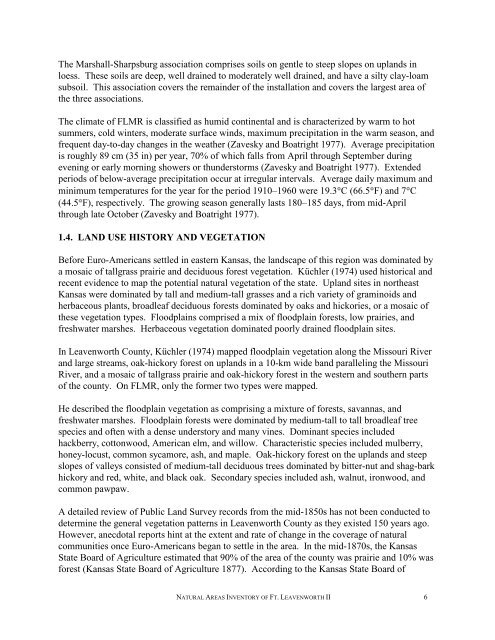A Natural Areas Inventory of the - Kansas Natural Heritage Inventory ...
A Natural Areas Inventory of the - Kansas Natural Heritage Inventory ...
A Natural Areas Inventory of the - Kansas Natural Heritage Inventory ...
Create successful ePaper yourself
Turn your PDF publications into a flip-book with our unique Google optimized e-Paper software.
The Marshall-Sharpsburg association comprises soils on gentle to steep slopes on uplands in<br />
loess. These soils are deep, well drained to moderately well drained, and have a silty clay-loam<br />
subsoil. This association covers <strong>the</strong> remainder <strong>of</strong> <strong>the</strong> installation and covers <strong>the</strong> largest area <strong>of</strong><br />
<strong>the</strong> three associations.<br />
The climate <strong>of</strong> FLMR is classified as humid continental and is characterized by warm to hot<br />
summers, cold winters, moderate surface winds, maximum precipitation in <strong>the</strong> warm season, and<br />
frequent day-to-day changes in <strong>the</strong> wea<strong>the</strong>r (Zavesky and Boatright 1977). Average precipitation<br />
is roughly 89 cm (35 in) per year, 70% <strong>of</strong> which falls from April through September during<br />
evening or early morning showers or thunderstorms (Zavesky and Boatright 1977). Extended<br />
periods <strong>of</strong> below-average precipitation occur at irregular intervals. Average daily maximum and<br />
minimum temperatures for <strong>the</strong> year for <strong>the</strong> period 1910–1960 were 19.3 C (66.5 F) and 7 C<br />
(44.5 F), respectively. The growing season generally lasts 180–185 days, from mid-April<br />
through late October (Zavesky and Boatright 1977).<br />
1.4. LAND USE HISTORY AND VEGETATION<br />
Before Euro-Americans settled in eastern <strong>Kansas</strong>, <strong>the</strong> landscape <strong>of</strong> this region was dominated by<br />
a mosaic <strong>of</strong> tallgrass prairie and deciduous forest vegetation. Küchler (1974) used historical and<br />
recent evidence to map <strong>the</strong> potential natural vegetation <strong>of</strong> <strong>the</strong> state. Upland sites in nor<strong>the</strong>ast<br />
<strong>Kansas</strong> were dominated by tall and medium-tall grasses and a rich variety <strong>of</strong> graminoids and<br />
herbaceous plants, broadleaf deciduous forests dominated by oaks and hickories, or a mosaic <strong>of</strong><br />
<strong>the</strong>se vegetation types. Floodplains comprised a mix <strong>of</strong> floodplain forests, low prairies, and<br />
freshwater marshes. Herbaceous vegetation dominated poorly drained floodplain sites.<br />
In Leavenworth County, Küchler (1974) mapped floodplain vegetation along <strong>the</strong> Missouri River<br />
and large streams, oak-hickory forest on uplands in a 10-km wide band paralleling <strong>the</strong> Missouri<br />
River, and a mosaic <strong>of</strong> tallgrass prairie and oak-hickory forest in <strong>the</strong> western and sou<strong>the</strong>rn parts<br />
<strong>of</strong> <strong>the</strong> county. On FLMR, only <strong>the</strong> former two types were mapped.<br />
He described <strong>the</strong> floodplain vegetation as comprising a mixture <strong>of</strong> forests, savannas, and<br />
freshwater marshes. Floodplain forests were dominated by medium-tall to tall broadleaf tree<br />
species and <strong>of</strong>ten with a dense understory and many vines. Dominant species included<br />
hackberry, cottonwood, American elm, and willow. Characteristic species included mulberry,<br />
honey-locust, common sycamore, ash, and maple. Oak-hickory forest on <strong>the</strong> uplands and steep<br />
slopes <strong>of</strong> valleys consisted <strong>of</strong> medium-tall deciduous trees dominated by bitter-nut and shag-bark<br />
hickory and red, white, and black oak. Secondary species included ash, walnut, ironwood, and<br />
common pawpaw.<br />
A detailed review <strong>of</strong> Public Land Survey records from <strong>the</strong> mid-1850s has not been conducted to<br />
determine <strong>the</strong> general vegetation patterns in Leavenworth County as <strong>the</strong>y existed 150 years ago.<br />
However, anecdotal reports hint at <strong>the</strong> extent and rate <strong>of</strong> change in <strong>the</strong> coverage <strong>of</strong> natural<br />
communities once Euro-Americans began to settle in <strong>the</strong> area. In <strong>the</strong> mid-1870s, <strong>the</strong> <strong>Kansas</strong><br />
State Board <strong>of</strong> Agriculture estimated that 90% <strong>of</strong> <strong>the</strong> area <strong>of</strong> <strong>the</strong> county was prairie and 10% was<br />
forest (<strong>Kansas</strong> State Board <strong>of</strong> Agriculture 1877). According to <strong>the</strong> <strong>Kansas</strong> State Board <strong>of</strong><br />
NATURAL AREAS INVENTORY OF FT. LEAVENWORTH II 6


